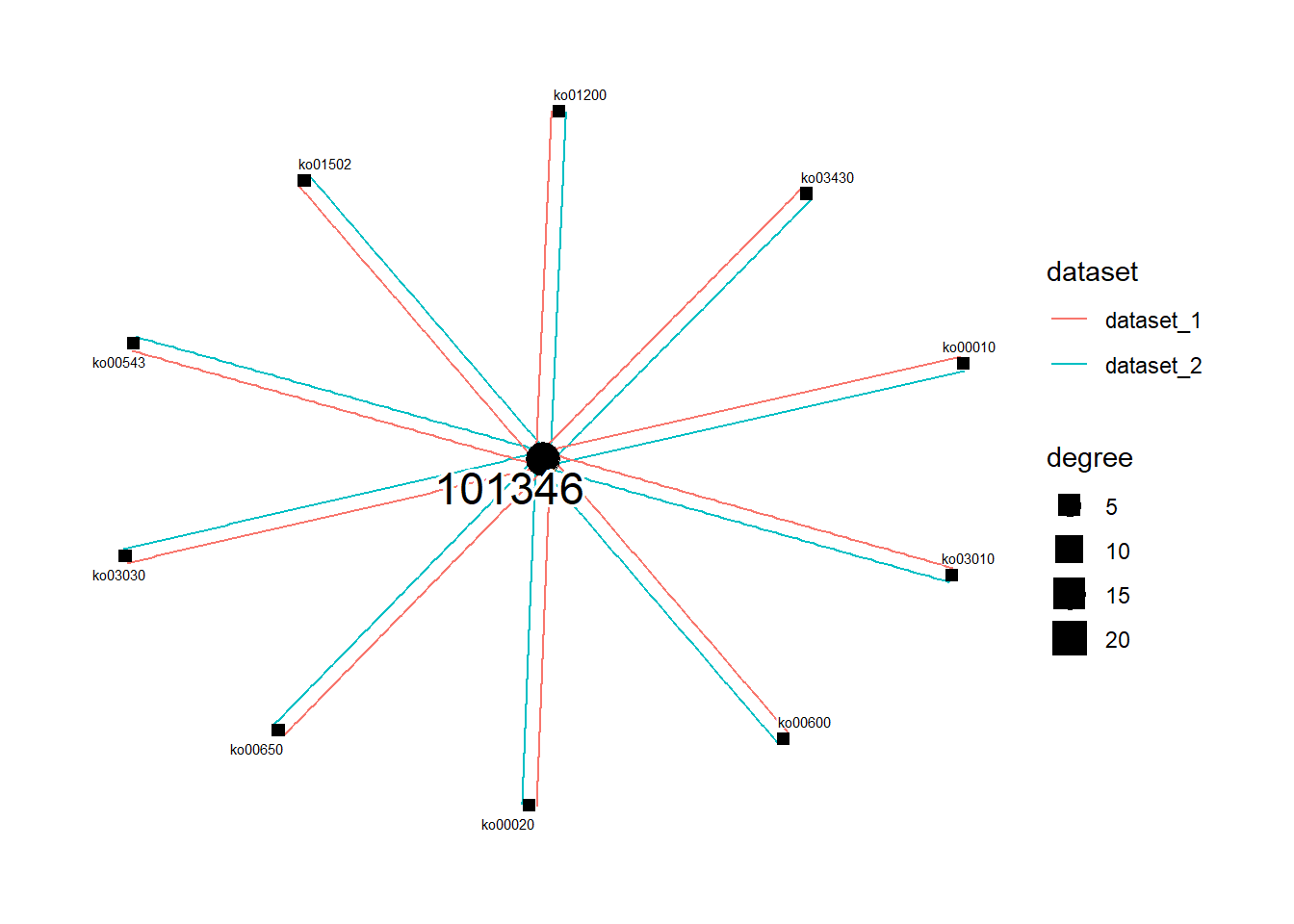4 Functional annotation
For metabolic functional profiling, several functions are prepared in stana. Note that these functions are primarily designed for KEGG ORTHOLOGY which can be subsequently linked to KEGG PATHWAY and the other databases in KEGG. However, the other options such as the enzyme commision numbers can be accepted.
library(stana)
library(ComplexHeatmap)
4.1 Parsing PATRIC results
If the gene IDs in the gene matrix stored in the stana object is PATRIC ID, we can use checkPATRIC function to obtain information related to PATRIC functional annotation. The function accepts the input of named list of genes, and returns functional annotation results. The function uses BiocFileCache() to cache the obtained results from API.
genes <- list("test"=read.table("../test_genes.txt")$V1)
genes |> head()
#> $test
#> [1] "1280701.3.peg.1153" "1280701.3.peg.1169"
#> [3] "1280701.3.peg.1174" "1280701.3.peg.1179"
#> [5] "1280701.3.peg.1186" "1280701.3.peg.203"
#> [7] "1280701.3.peg.361" "1280701.3.peg.363"
#> [9] "1280701.3.peg.368" "1280701.3.peg.369"
#> [11] "1280701.3.peg.570" "1280701.3.peg.758"
#> [13] "1280701.3.peg.762" "1410605.3.peg.1201"
#> [15] "1410605.3.peg.1204" "1410605.3.peg.1463"
#> [17] "1410605.3.peg.1510" "1410605.3.peg.1568"
#> [19] "1410605.3.peg.450" "1410605.3.peg.593"
#> [21] "1410605.3.peg.655" "1410605.3.peg.833"
#> [23] "1410605.3.peg.844" "1410605.3.peg.903"
#> [25] "1410605.3.peg.953" "1447715.5.peg.1455"
#> [27] "1447715.5.peg.1549" "1447715.5.peg.1582"
#> [29] "1447715.5.peg.256" "1447715.5.peg.33"
#> [31] "1447715.5.peg.566" "1447715.5.peg.964"
res <- checkPATRIC(genes, "pathway_name")
#> Obtaining annotations of 3 genomes
#> Obtaining information on 1280701.3
#> Obtaining information on 1410605.3
#> Obtaining information on 1447715.5
#> Checking results on cluster test
#> total of 2 annotation obtained
#> remove duplicate based on pathway_name
#> total of 2 annotation obtained after removal of duplication
DT::datatable(res$test$DF, options = list(scrollX=TRUE))4.1.1 Draw the network
You can draw the graph of obtained results depicting enzyme to KEGG PATHWAY relationship.
drawPATRIC(genes)
#> Obtaining annotations of 3 genomes
#> Obtaining information on 1280701.3
#> Obtaining information on 1410605.3
#> Obtaining information on 1447715.5
#> Checking results on cluster test
#> total of 2 annotation obtained
#> remove duplicate based on ec_description
#> total of 2 annotation obtained after removal of duplication
#> Making graph on pathway_name and ec_description
#> subsetting to 5 label on each category
#> $test
#> $test$DF
#> patric_id ec_number
#> 254 fig|1280701.3.peg.570 4.2.1.51
#> 608 fig|1280701.3.peg.1186 2.1.1.37
#> ec_description pathway_id
#> 254 Prephenate dehydratase 400
#> 608 DNA (cytosine-5-)-methyltransferase 270
#> pathway_name
#> 254 Phenylalanine, tyrosine and tryptophan biosynthesis
#> 608 Cysteine and methionine metabolism
#>
#> $test$REMOVEDUP
#> patric_id ec_number
#> 254 fig|1280701.3.peg.570 4.2.1.51
#> 608 fig|1280701.3.peg.1186 2.1.1.37
#> ec_description pathway_id
#> 254 Prephenate dehydratase 400
#> 608 DNA (cytosine-5-)-methyltransferase 270
#> pathway_name
#> 254 Phenylalanine, tyrosine and tryptophan biosynthesis
#> 608 Cysteine and methionine metabolism
#>
#> $test$SORTED
#>
#> DNA (cytosine-5-)-methyltransferase
#> 1
#> Prephenate dehydratase
#> 1
#>
#> $test$GRAPH
#> IGRAPH 18591ff UN-- 4 2 --
#> + attr: name (v/c)
#> + edges from 18591ff (vertex names):
#> [1] Prephenate dehydratase --Phenylalanine, tyrosine and tryptophan biosynthesis
#> [2] DNA (cytosine-5-)-methyltransferase--Cysteine and methionine metabolism
#>
#> $test$PLOT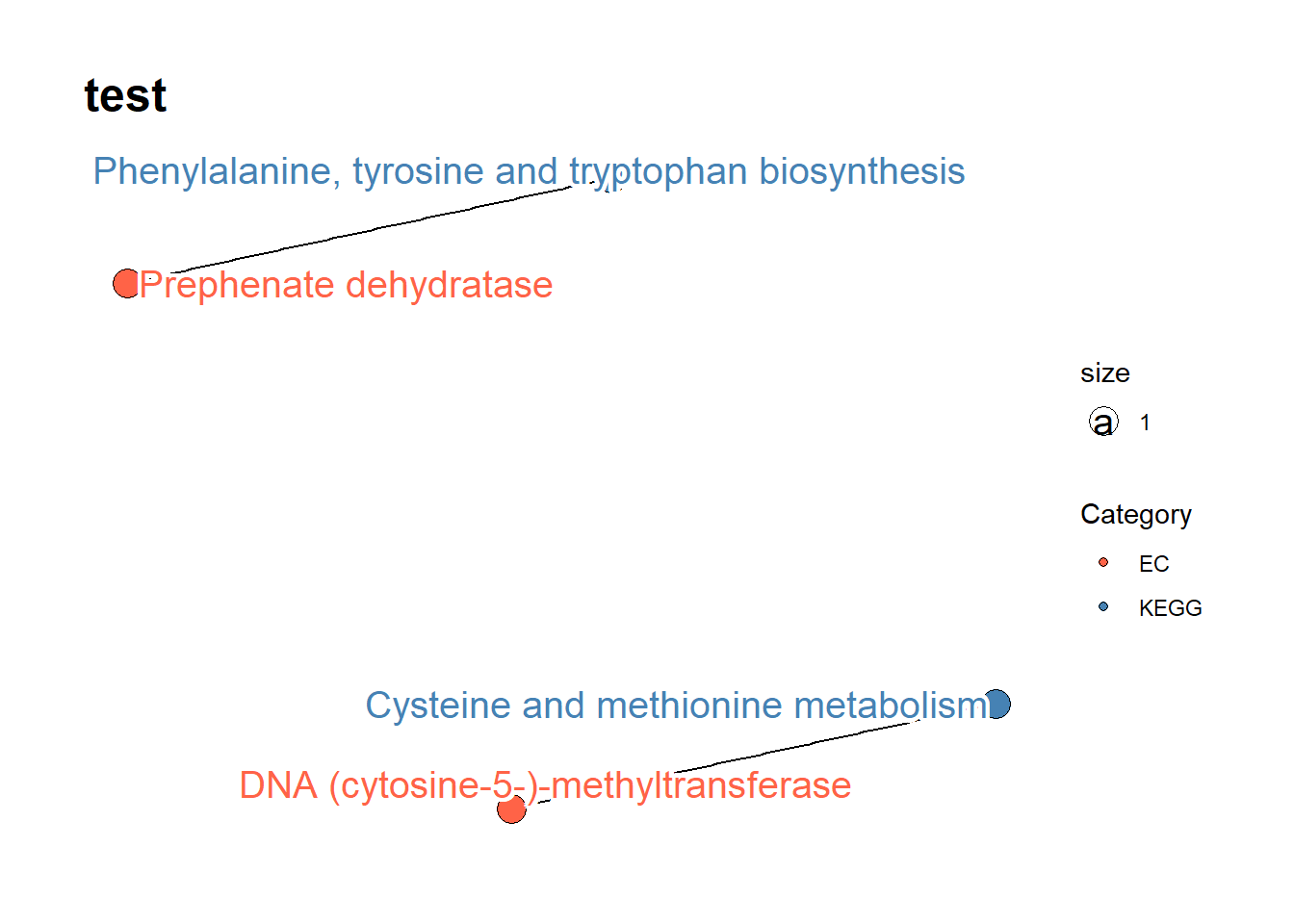
4.2 Parsing eggNOG-mapper v2 results
If the genes are not annotated, one can use annotation software and produces an assignment file. We can use checkEGGNOG function to read the output of eggNOG-mapper v2.
You should perform the annotation to genes using the server or the software.
Specify IDs you want to obtain to ret, such as “KEGG_ko” and “KEGG_Pathway”.
The annotation can be used with the other functions.
tib <- checkEGGNOG("../annotations_gtdb/100224_eggnog_out.emapper.annotations",
ret="KEGG_ko")
tib |> head() |> DT::datatable()4.2.1 Draw the network
You can draw the relationships between IDs by drawEGGNOG.
drawEGGNOG("../annotations_gtdb/100224_eggnog_out.emapper.annotations",
candPlot = c("KEGG_ko","KEGG_Pathway"),
geneIDs = tib$ID |> head(100))
#> $graph
#> IGRAPH 194655f UN-- 21 922 --
#> + attr: name (v/c), category (v/c), size (v/n)
#> + edges from 194655f (vertex names):
#> [1] ko:K11533--ko00061 ko:K11533--ko01100
#> [3] ko:K11533--ko01212 ko:K11533--ko04931
#> [5] ko:K11533--ko00061 ko:K11533--ko01100
#> [7] ko:K11533--ko01212 ko:K11533--ko04931
#> [9] ko:K11533--ko00061 ko:K11533--ko01100
#> [11] ko:K11533--ko01212 ko:K11533--ko04931
#> [13] ko:K11533--ko00061 ko:K11533--ko01100
#> [15] ko:K11533--ko01212 ko:K11533--ko04931
#> + ... omitted several edges
#>
#> $plot
4.3 Heatmap of the gene copy numbers with functional annotations
You can inspect the overview of functional differences using gene copy numbers along with simplifyEnrichment. The plotHeatmap function can be used with the stana object or preprocessed gene copy number matrix as input. In the function, anno_PATRIC_keywords and anno_eggNOG_keywords are used to plot the word clouds alongside Heatmap from ComplexHeatmap. It is easy for MIDAS, as the function obtains functional annotation from PATRIC API server and no annotation step is needed.
4.3.1 MIDAS
For MIDAS, the function automatically query API of PATRIC server using the gene names. As the gene number is large typically, one can filter the genes by options filter_zero_frac, filter_max_frac and filter_max_value. However, one should perform own filtering beforehand and provide the matrix to mat. If mat is specified, other filtering options will be ignored.
library(ComplexHeatmap)
library(simplifyEnrichment)
load("../hd_meta.rda")
stana <- loadMIDAS("../merge_midas1/", cl=hd_meta, candSp="Bacteroides_uniformis_57318")
#> Bacteroides_uniformis_57318
#> Snps
#> HC 13
#> R 16
#> Bacteroides_uniformis_57318 cleared filtering threshold in SNV
#> Genes
#> HC 13
#> R 16
#> Bacteroides_uniformis_57318 cleared filtering threshold in genes
#> Overall, 1 species met criteria in SNPs
#> Overall, 1 species met criteria in genes
plotHeatmap(stana, "Bacteroides_uniformis_57318",
filter_max_value = 2, filter_max_frac = 0)
#> # In resulting matrix, max: 1.99955229433902 min: 0
#> # Dimension: 4911 29
#> Obtaining gene information from PATRIC server
#> Obtaining annotations of 7 genomes
#> Obtaining information on 1235787.3
#> Obtaining information on 1339348.3
#> Obtaining information on 411479.10
#> Obtaining information on 457393.3
#> Obtaining information on 585543.3
#> Obtaining information on 997889.3
#> Obtaining information on 997890.3
#> Checking results on cluster 1
#> total of 557 annotation obtained
#> remove duplicate based on pathway_name
#> total of 534 annotation obtained after removal of duplication
#> Checking results on cluster 2
#> total of 28 annotation obtained
#> remove duplicate based on pathway_name
#> total of 28 annotation obtained after removal of duplication
#> Checking results on cluster 3
#> total of 154 annotation obtained
#> remove duplicate based on pathway_name
#> total of 153 annotation obtained after removal of duplication
#> Checking results on cluster 4
#> total of 1445 annotation obtained
#> remove duplicate based on pathway_name
#> total of 1403 annotation obtained after removal of duplication
#> Checking results on cluster 5
#> total of 1015 annotation obtained
#> remove duplicate based on pathway_name
#> total of 975 annotation obtained after removal of duplication
#> Checking results on cluster 6
#> total of 371 annotation obtained
#> remove duplicate based on pathway_name
#> total of 366 annotation obtained after removal of duplication
#> Checking results on cluster 7
#> total of 346 annotation obtained
#> remove duplicate based on pathway_name
#> total of 341 annotation obtained after removal of duplication
#> Checking results on cluster 8
#> total of 279 annotation obtained
#> remove duplicate based on pathway_name
#> total of 272 annotation obtained after removal of duplication
#> Checking results on cluster 9
#> total of 1012 annotation obtained
#> remove duplicate based on pathway_name
#> total of 971 annotation obtained after removal of duplication
#> Checking results on cluster 10
#> total of 878 annotation obtained
#> remove duplicate based on pathway_name
#> total of 844 annotation obtained after removal of duplication
4.3.2 The other types
The users should provide eggNOG annotation on eggNOG slot of stana object. fnc argument accepts KEGG_Pathway or KEGG_Module available in eggNOG annotation. The function queries KEGG REST API to obtain pathway and module description.
load("../hd_meta.rda")
stana <- loadMIDAS2("../merge_uhgg", cl=hd_meta, candSp=c("101346"), db="uhgg")
#> 101346
#> g__Bacteroides;s__Bacteroides uniformis
#> Number of snps: 70178
#> Number of samples: 28
#> 101346
#> g__Bacteroides;s__Bacteroides uniformis
#> Number of genes: 120158
#> Number of samples: 31We set the eggNOG-mapper v2 annotation file to the eggNOG slot of stana object.
This can be done by setAnnotation function.
## Set the annotation file
stana <- setAnnotation(stana, list("101346"="../annotations_uhgg/101346_eggnog_out.emapper.annotations"))You can set removeAdditional argument to filter words that are to be displayed.
library(ComplexHeatmap)
library(simplifyEnrichment)
plotHeatmap(stana, "101346",
fnc="KEGG_Module",
removeAdditional=c("cycle","pathway"),
filter_zero_frac = 0.5,
filter_max_frac = 0,
filter_max_value = 5)
#> # In resulting matrix, max: 4.999739 min: 0
#> # Dimension: 3501 31
#> # Looking for the annotation file by eggNOG-mapper v2
#> # Loading annotation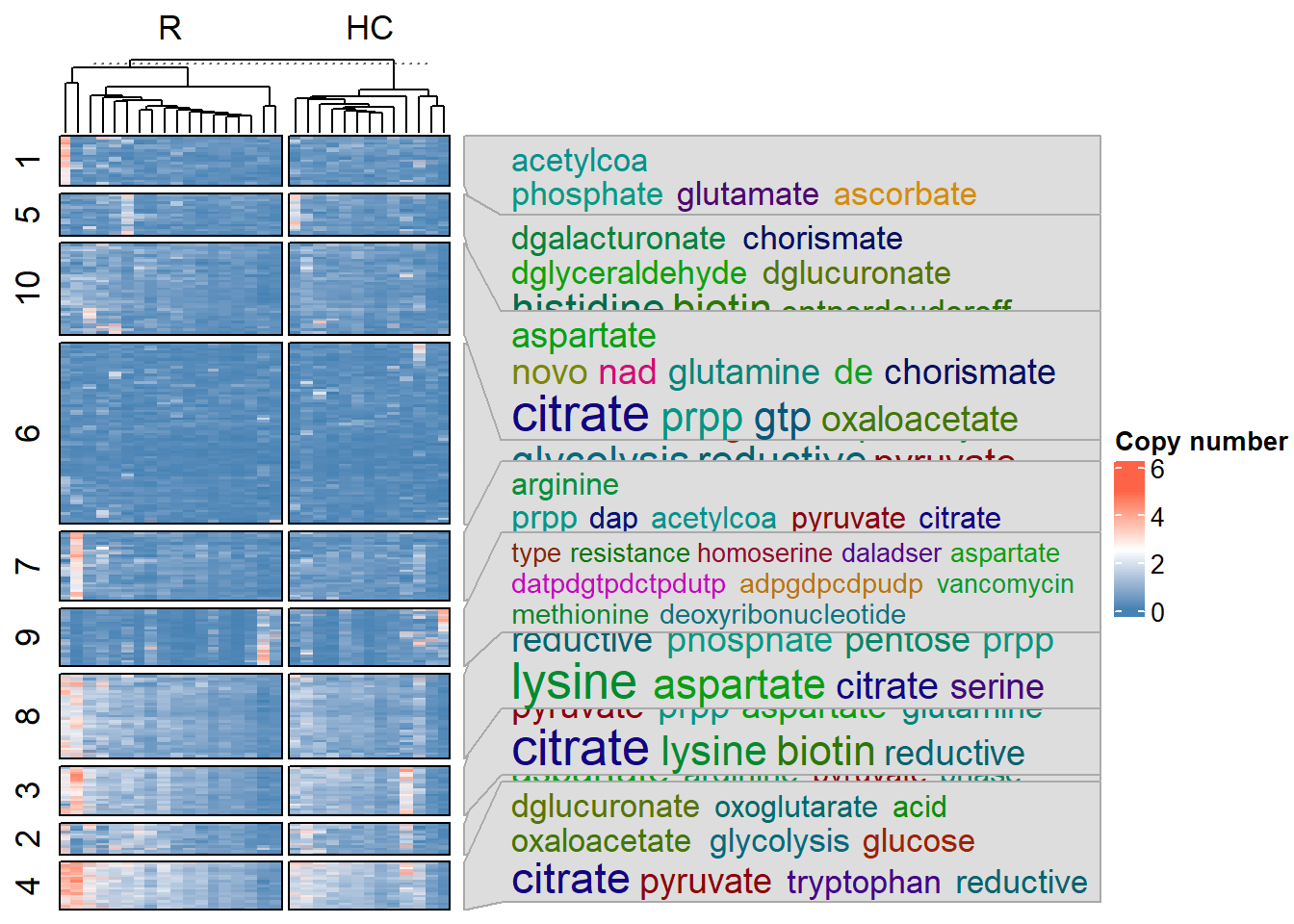
The gene IDs can be subset by providing the IDs to the geneID option. If variable is set to other than zero, the genes with top-{variable} variable features were subset to be used in the heatmap visualization.
## Subset to top-100 variable genes
plotHeatmap(stana, "101346", variable=100)
#> # In resulting matrix, max: 49.729167 min: 0
#> # Dimension: 18808 31
#> # Looking for the annotation file by eggNOG-mapper v2
#> # Loading annotation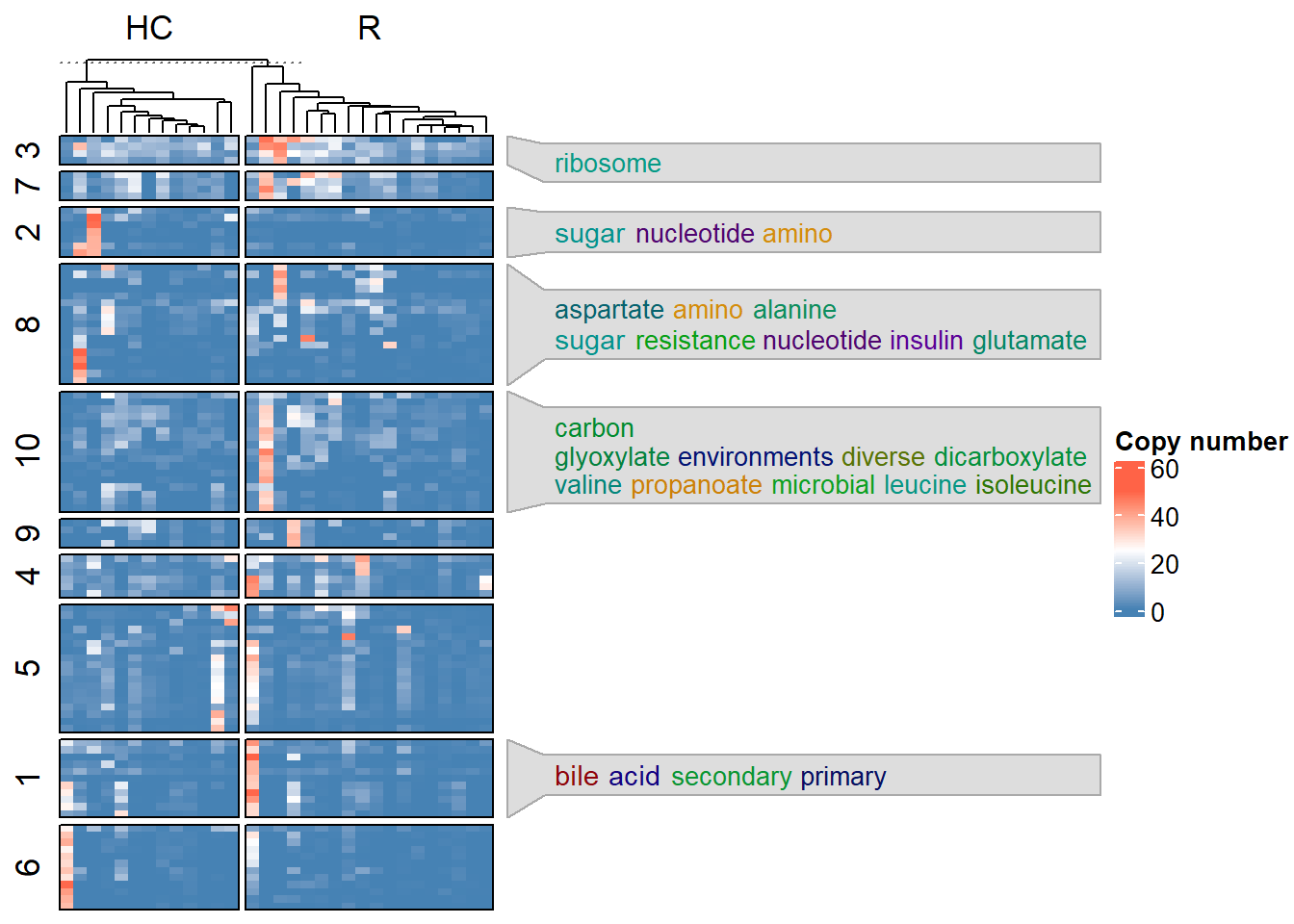
4.4 Aggregate the gene copy numbers based on the annotations
calcGF function can aggregate the gene copy numbers based on the annotation (eggNOG) or the manually set annotation.
## Default to use eggNOG annotation, and the user can specify which gene family to summarize
stana <- calcGF(stana, "101346", column="EC")
getSlot(stana, "kos")[["101346"]] %>% head()
#> ERR9492489 ERR9492490 ERR9492491 ERR9492492
#> 3.6.4.12 39.173924 95.450865 52.767661 46.882936
#> 3.4.24.40 0.000000 0.841116 0.278746 0.000000
#> 3.2.1.14 1.198363 5.697443 2.435163 0.298239
#> 4.2.2.23 1.586967 8.950180 3.871217 0.326971
#> 2.7.11.1 7.415218 17.180451 17.557883 12.640404
#> 3.1.3.90 0.000000 0.000000 0.000000 0.000000
#> ERR9492493 ERR9492494 ERR9492495 ERR9492496
#> 3.6.4.12 109.030709 38.157274 61.418044 32.840106
#> 3.4.24.40 2.289508 0.000000 0.000000 0.000000
#> 3.2.1.14 4.716068 0.565635 3.950550 0.842613
#> 4.2.2.23 2.222589 2.685389 1.223989 0.547461
#> 2.7.11.1 13.093117 16.668716 9.321875 3.957696
#> 3.1.3.90 0.309415 0.000000 0.000000 0.000000
#> ERR9492497 ERR9492498 ERR9492499 ERR9492500
#> 3.6.4.12 75.977012 28.210277 61.693399 36.666227
#> 3.4.24.40 1.190823 0.117354 0.276488 0.000000
#> 3.2.1.14 3.989812 0.833608 2.955427 1.241877
#> 4.2.2.23 2.361721 0.534308 2.707128 0.000000
#> 2.7.11.1 24.343595 8.375070 15.225822 9.506420
#> 3.1.3.90 0.399345 0.000000 0.334459 0.000000
#> ERR9492501 ERR9492503 ERR9492504 ERR9492505
#> 3.6.4.12 48.993525 58.889647 41.316522 44.670327
#> 3.4.24.40 0.605779 0.000000 1.281429 0.431620
#> 3.2.1.14 6.470900 2.073627 1.787648 1.916355
#> 4.2.2.23 6.066784 3.795593 0.000000 1.875545
#> 2.7.11.1 21.694552 19.085136 15.225251 12.040248
#> 3.1.3.90 0.328735 0.210771 0.000000 0.133266
#> ERR9492507 ERR9492509 ERR9492510 ERR9492511
#> 3.6.4.12 30.414200 94.222205 67.033382 45.280463
#> 3.4.24.40 0.000000 0.000000 0.582293 0.050622
#> 3.2.1.14 0.113379 9.611853 3.004519 0.816464
#> 4.2.2.23 5.876491 9.608170 6.104285 0.227825
#> 2.7.11.1 15.459505 48.563617 16.882499 6.723153
#> 3.1.3.90 0.000000 0.330640 0.000000 0.209655
#> ERR9492512 ERR9492513 ERR9492514 ERR9492515
#> 3.6.4.12 37.248780 92.564239 44.501316 33.343923
#> 3.4.24.40 0.000000 0.699384 0.809852 0.000000
#> 3.2.1.14 2.928634 3.767824 1.008637 0.391071
#> 4.2.2.23 0.200991 2.143717 0.000000 2.435797
#> 2.7.11.1 13.147839 19.027770 17.290957 8.964407
#> 3.1.3.90 0.000000 0.000000 0.000000 0.000000
#> ERR9492519 ERR9492521 ERR9492522 ERR9492523
#> 3.6.4.12 123.352975 19.992745 113.496963 73.578048
#> 3.4.24.40 0.612824 0.044187 0.000000 0.289869
#> 3.2.1.14 2.685511 0.555955 4.377865 4.203646
#> 4.2.2.23 7.924792 2.183619 8.216322 2.000771
#> 2.7.11.1 21.618306 16.281798 27.935448 8.713224
#> 3.1.3.90 0.745864 0.064679 0.000000 0.270559
#> ERR9492525 ERR9492526 ERR9492528
#> 3.6.4.12 22.958707 64.120946 37.810981
#> 3.4.24.40 0.048448 0.548795 0.000000
#> 3.2.1.14 0.671990 4.579498 2.684535
#> 4.2.2.23 2.174417 9.497381 3.574399
#> 2.7.11.1 3.474492 16.346382 10.342824
#> 3.1.3.90 0.147197 0.000000 0.0000004.5 KGEG PATHWAY and KEGG ORTHOLOGY
4.5.1 Visualization of KEGG PATHWAY
KEGG PATHWAY is frequently used to characterize metabolic function of microbiome. Utilizing ggkegg, the information of intra-species diversity, particulary gene copy number differences, can be reflected onto KEGG PATHWAY. It needs genes slot filled, and some annotations files, typically eggNOG-mapper v2, are needed.
4.5.1.1 Visualizing differences per species
Load the profile for multiple species.
load("../hd_meta.rda")
stana <- loadMIDAS2("../merge_uhgg", cl=hd_meta, candSp=c("101346","102438"), db="uhgg")
#> 101346
#> g__Bacteroides;s__Bacteroides uniformis
#> Number of snps: 70178
#> Number of samples: 28
#> 102438
#> g__Parabacteroides;s__Parabacteroides distasonis
#> Number of snps: 18102
#> Number of samples: 28
#> 101346
#> g__Bacteroides;s__Bacteroides uniformis
#> Number of genes: 120158
#> Number of samples: 31
#> 102438
#> g__Parabacteroides;s__Parabacteroides distasonis
#> Number of genes: 47046
#> Number of samples: 29Next, we set the eggNOG-mapper v2 annotation file to the eggNOG slot of stana object.
This way, the plotKEGGPathway function automatically calculates the copy numbers by user-defined method.
## Set the annotation file
stana <- setAnnotation(stana, list("101346"="../annotations_uhgg/101346_eggnog_out.emapper.annotations",
"102438"="../annotations_uhgg/102438_eggnog_out.emapper.annotations"))plotKEGGPathway can be run by providing stana object, species (when multiple species, rectangular nodes will be split),
and pathway ID to visualize. Here, we visualize ko00620, Pyruvate metabolism for example. As for the large annotation table, the calculation takes time and you can provide pre-calculated KO table in kos slot of stana object, or specify only_ko = TRUE to first return KO table.
stana <- plotKEGGPathway(stana, c("101346","102438"), pathway_id="ko00620", only_ko=TRUE, multi_scale=FALSE)
gg <- plotKEGGPathway(stana, c("101346","102438"), pathway_id="ko00620", multi_scale=FALSE)
#> Using pre-computed KO table
#> Using pre-computed KO table
#> 101346: HC / R
#> 102438: HC / R
gg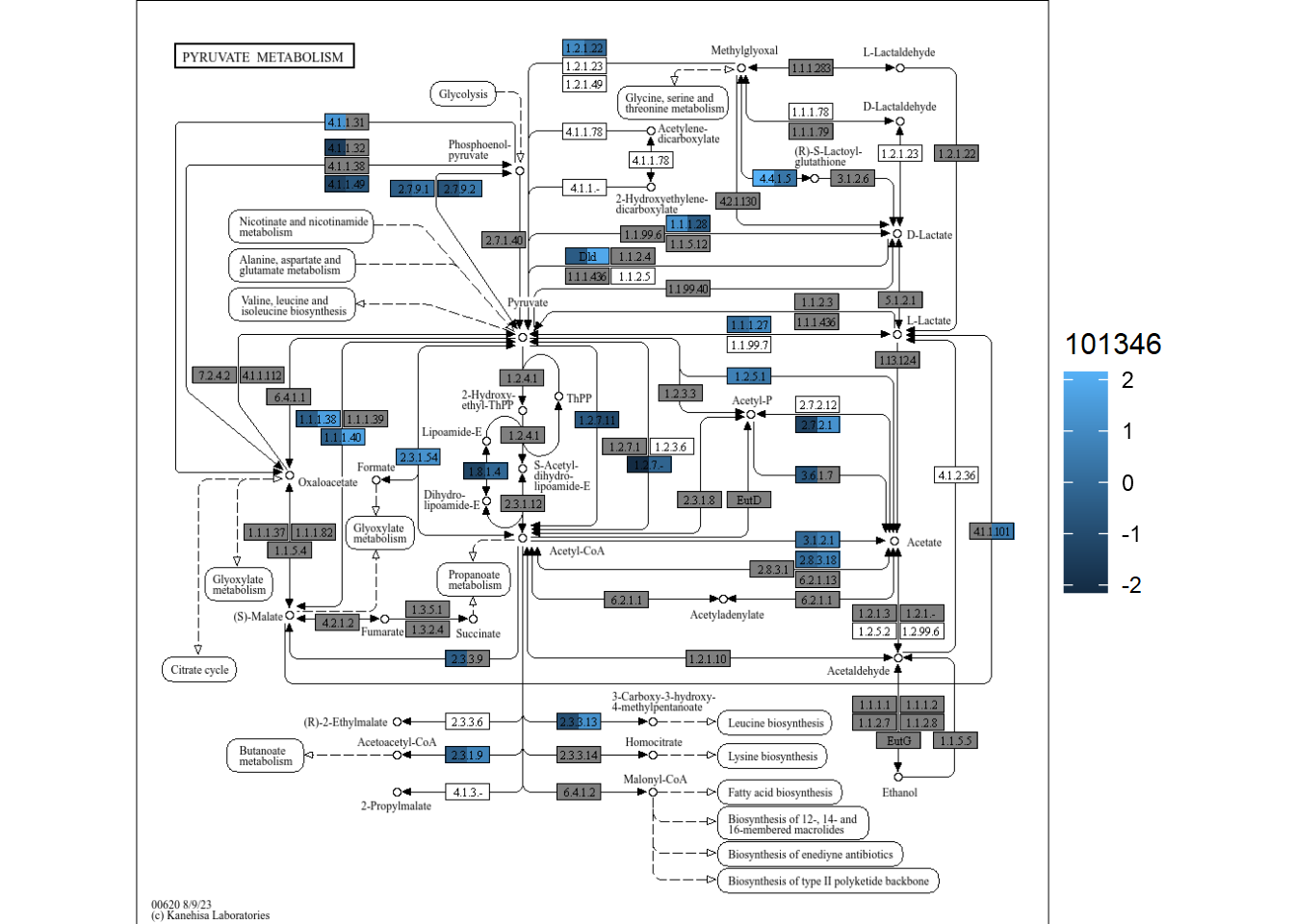
By default, the scale is same. If you install ggh4x, multiple scales can be added, by specifying multi_scale argument.
gg <- plotKEGGPathway(stana, c("101346","102438"), pathway_id="ko00620", multi_scale=TRUE)
#> Using pre-computed KO table
#> Using pre-computed KO table
#> 101346: HC / R
#> 102438: HC / R
gg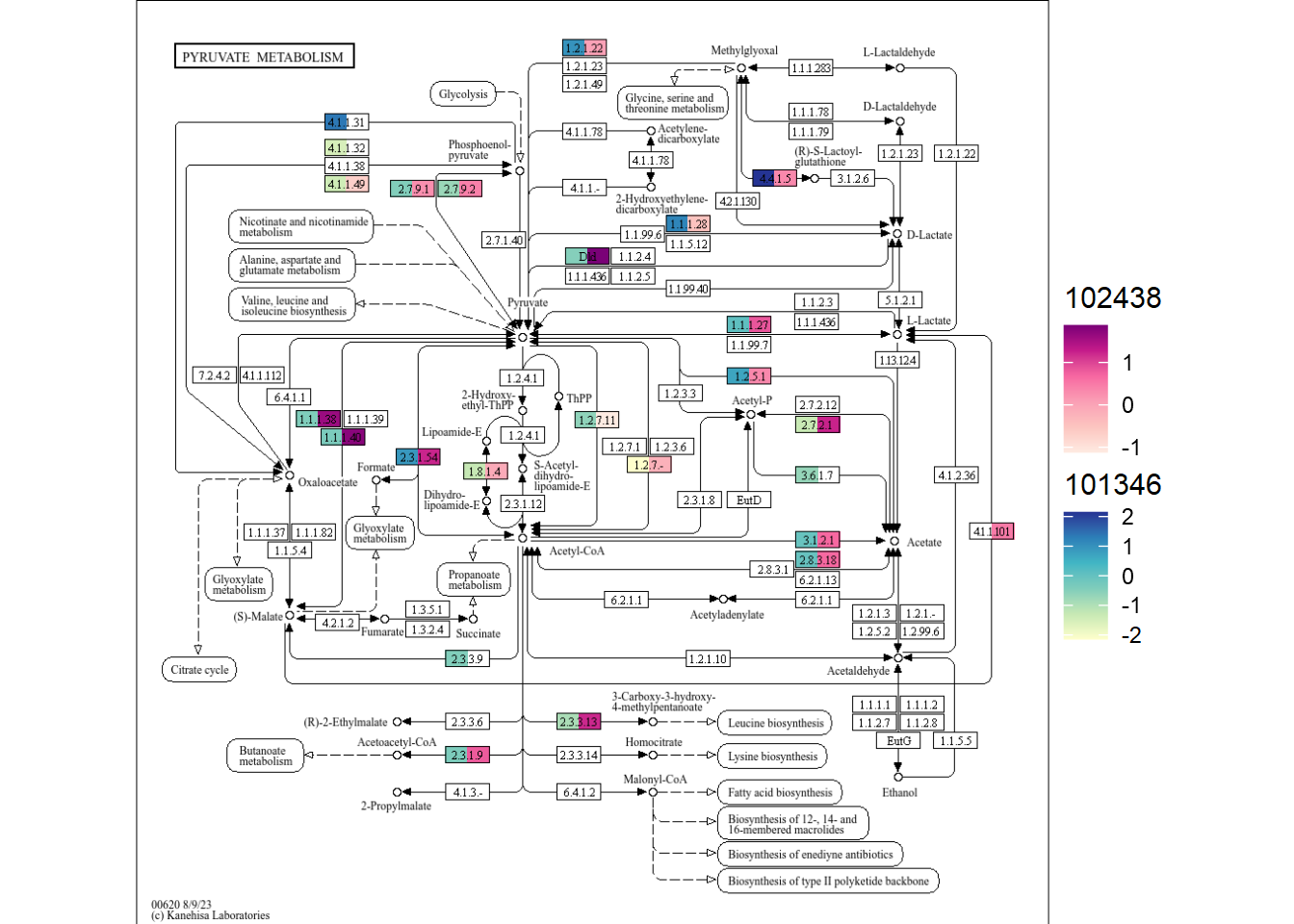
You can provide multiple pathway IDs to pathway_id, which returns a list of plot.
gg <- plotKEGGPathway(stana, c("101346","102438"),
pathway_id=c("ko00270","ko00620"),
multi_scale=TRUE)
#> Using pre-computed KO table
#> Using pre-computed KO table
#> 101346: HC / R
#> 102438: HC / R
gg2 <- patchwork::wrap_plots(gg)
gg2
In this way, differences in orthologies in the pathway across multiple species can be readily captured.
4.5.2 Visualizing calculated values across species
If you want to see the sum values across species, you can set option summarize=TRUE. This way, the KO values across specified species are summed, and compared between groups, then plotted.
gg <- plotKEGGPathway(stana, c("101346","102438"),
pathway_id=c("ko00270","ko00620"),
summarize=TRUE)
#> Using pre-computed KO table
#> Using pre-computed KO table
#> 102438: HC / R
gg2 <- patchwork::wrap_plots(gg)
gg2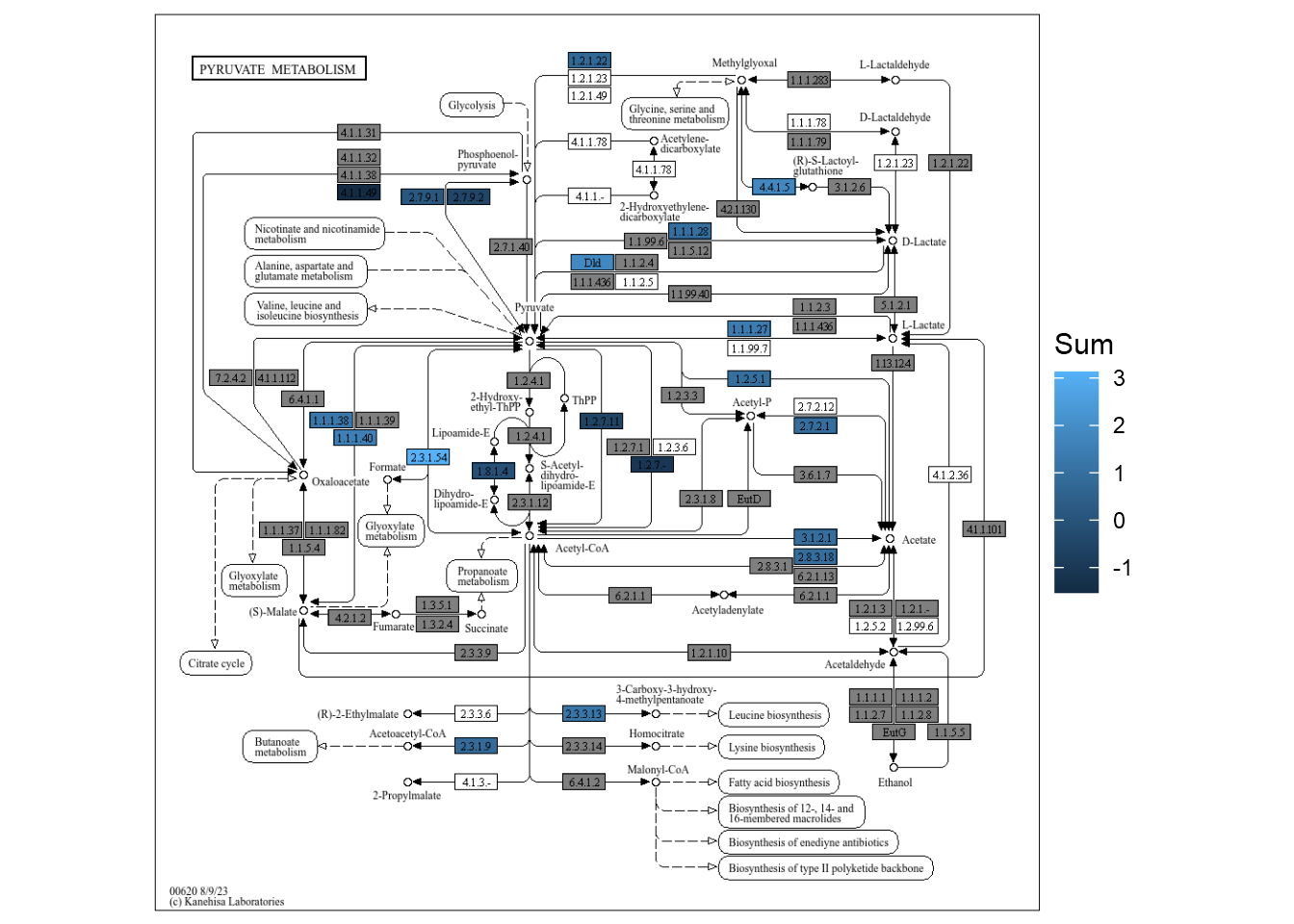
4.5.3 Show which species have the KOs
If you specify point_mode=TRUE, the function plot points on the KOs on the pathways
based on whether the specified species have the corresponding KOs annotated.
gg <- plotKEGGPathway(stana, c("101346","102438"),
pathway_id=c("ko00270"),
sp_colors=c("blue","red") |> setNames(c("101346","102438")),
point_mode=TRUE)
#> Using pre-computed KO table
#> Using pre-computed KO table
#> 101346: HC / R
#> 102438: HC / R
#> Point mode enabled
gg
#> $ko00270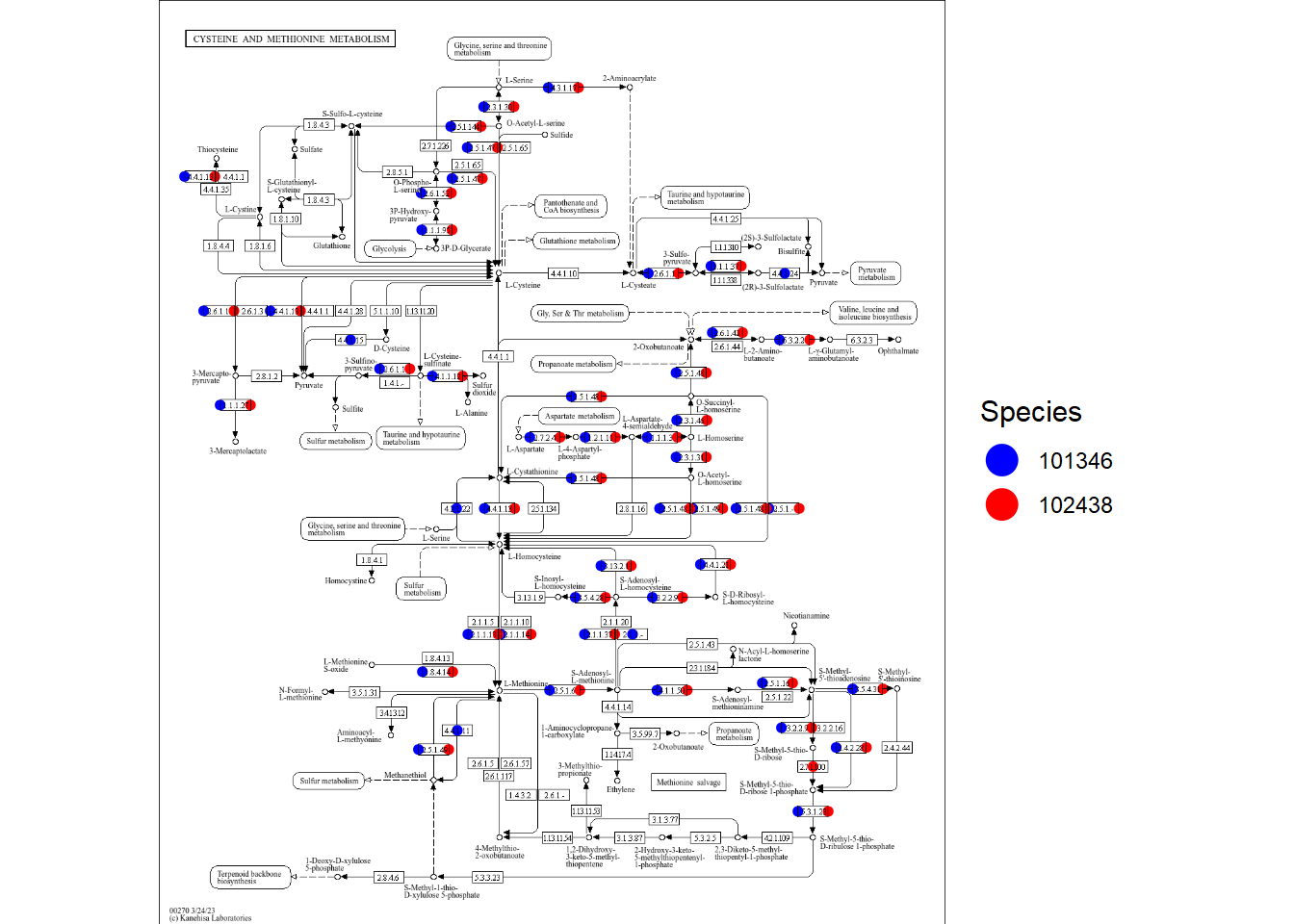
4.5.4 Ranking the components in the graph
By using calculated statistics of gene family (in this case, KO), one can rank the compounds catalyzed by these enzymes using graph information. Specify the candidate species ID and pathway ID and the function automatically calculates the values.
library(tidygraph)
rankComponents(stana, pid="ko00270", candSp="102438")
#> # Using pre-computed KO table
#> # HC / R
#> name rank
#> 1 cpd:C02218 1.54370291
#> 2 cpd:C09306 1.40561913
#> 3 cpd:C00041 1.40561913
#> 4 cpd:C01077 1.10144476
#> 5 cpd:C00263 1.09552071
#> 6 cpd:C01118 0.99254895
#> 7 cpd:C03082 0.89568277
#> 8 cpd:C05823 0.87235086
#> 9 cpd:C00049 0.60348505
#> 10 cpd:C03539 0.36484440
#> 11 cpd:C05527 -0.08284236
#> 12 cpd:C03232 -0.59819630
#> 13 cpd:C02989 -1.18193737
#> 14 cpd:C00197 -1.504535974.6 Setting the manual annotation
Using setMap function, one can set stana object a named data frame of mapping file between gene and gene families.
In this case, the data.frame should be two column layouts, and the first column corresponds to gene ID and the second column corresponds to the gene family IDs.
stana <- setMap(stana, "101346", data.frame(c("geneID1","geneID2"), c("K00001","K00002")))
4.7 pathwayWithFactor
The KO copy numbers can be aggregated to KEGG PATHWAY profiles by pathwayWithFactor.
By default, the function uses the KO matrix from NMF slot. mat can be specified for the other matrices.
## Row.names: KO, colnames: Samples
ch <- getSlot(stana, "kos")[["101346"]]
head(pathwayWithFactor(stana, "101346", summarize=mean, mat=ch))
#> ERR9492489 ERR9492490 ERR9492491 ERR9492492
#> path:ko00010 0.03877215 0.13322643 0.04001532 0.06391891
#> path:ko00020 0.03425545 0.12828687 0.03985006 0.07768581
#> path:ko00030 0.04703528 0.13909857 0.06912219 0.04676925
#> path:ko00040 0.04000612 0.17272473 0.06849944 0.05096996
#> path:ko00051 0.05214005 0.07052621 0.06382708 0.03420876
#> path:ko00052 0.06397950 0.07191146 0.04914795 0.03673800
#> ERR9492493 ERR9492494 ERR9492495 ERR9492496
#> path:ko00010 0.09384163 0.05637166 0.06068150 0.02861835
#> path:ko00020 0.08709860 0.06347143 0.08655160 0.02838112
#> path:ko00030 0.09236281 0.06725684 0.09888781 0.06070932
#> path:ko00040 0.09423838 0.09310127 0.09308659 0.04017714
#> path:ko00051 0.05898339 0.06181811 0.05094572 0.04122640
#> path:ko00052 0.06410715 0.05452204 0.14107086 0.03358680
#> ERR9492497 ERR9492498 ERR9492499 ERR9492500
#> path:ko00010 0.08451250 0.03267193 0.09284024 0.06000493
#> path:ko00020 0.06743175 0.02951531 0.09662457 0.05163185
#> path:ko00030 0.11954092 0.04752626 0.09501196 0.12192500
#> path:ko00040 0.09575037 0.04763954 0.09862459 0.05061098
#> path:ko00051 0.08917651 0.04097972 0.09009920 0.09712665
#> path:ko00052 0.10890301 0.03198491 0.04649193 0.08376906
#> ERR9492501 ERR9492503 ERR9492504 ERR9492505
#> path:ko00010 0.06353951 0.07530207 0.07413198 0.03851865
#> path:ko00020 0.06736760 0.05907952 0.08066299 0.03291251
#> path:ko00030 0.08062611 0.10059762 0.09074628 0.06140277
#> path:ko00040 0.05230380 0.10797610 0.05192520 0.04096908
#> path:ko00051 0.07521150 0.06162177 0.06966618 0.03856838
#> path:ko00052 0.07510973 0.05448280 0.08440857 0.05159773
#> ERR9492507 ERR9492509 ERR9492510 ERR9492511
#> path:ko00010 0.04408184 0.1101960 0.06831861 0.04457377
#> path:ko00020 0.03055716 0.1122648 0.05686148 0.03786649
#> path:ko00030 0.05901192 0.2060442 0.07937786 0.06227169
#> path:ko00040 0.04993012 0.1811532 0.12112892 0.06357970
#> path:ko00051 0.03501170 0.1072305 0.09978821 0.04688276
#> path:ko00052 0.03050457 0.1082022 0.09676729 0.05031496
#> ERR9492512 ERR9492513 ERR9492514 ERR9492515
#> path:ko00010 0.05663017 0.11421784 0.08596117 0.03688230
#> path:ko00020 0.04904705 0.09192427 0.07901509 0.04271306
#> path:ko00030 0.07407402 0.10263472 0.11231495 0.04835473
#> path:ko00040 0.04686250 0.10666516 0.07078609 0.05789550
#> path:ko00051 0.04646515 0.10730369 0.07973031 0.03461777
#> path:ko00052 0.05438493 0.07782405 0.09124815 0.04582225
#> ERR9492519 ERR9492521 ERR9492522 ERR9492523
#> path:ko00010 0.2020544 0.03199985 0.11593241 0.06408050
#> path:ko00020 0.1902600 0.02793804 0.16804823 0.07081124
#> path:ko00030 0.1585779 0.05154594 0.11458300 0.06178188
#> path:ko00040 0.1028053 0.04093270 0.13291912 0.07091612
#> path:ko00051 0.1608883 0.03638188 0.25908852 0.04935026
#> path:ko00052 0.1023709 0.02991019 0.07093243 0.05402583
#> ERR9492525 ERR9492526 ERR9492528
#> path:ko00010 0.02762329 0.07007589 0.05262720
#> path:ko00020 0.02638546 0.05562837 0.04079618
#> path:ko00030 0.04034426 0.08332154 0.09070246
#> path:ko00040 0.02860687 0.09845644 0.06750199
#> path:ko00051 0.03293917 0.08427063 0.06058627
#> path:ko00052 0.04860460 0.08358931 0.056418484.8 GSEA
The gene set enrichment analysis based on the background KEGG PATHWAY information is possible if the KO copy numbers are used. doGSEA function performs GSEA on the gene copy number table based on the grouping variable set in the stana object. The background set is obtained by KEGG REST API. The gsea slot is filled with the function.
Note that background gene set contains the human disease category and the results should be taken care of with caution.
library(clusterProfiler)
stana <- doGSEA(stana, "101346")
#> HC / RplotGSEA function can be used to draw a network representation of species ID and differential pathway at the specified threshold. List of multiple stana objects can be passed to the function, which helps interpret the inter-dataset (like diseases) differences of intra-species diversity. This function returns the plot by default, but return_graph can be set to TRUE to return only the tbl_graph object. Also, layout can be specified by layout argument.
library(dplyr);library(tidygraph);library(ggraph)
plotGSEA(list(stana, stana), padjThreshold=0.2, layout="fr")